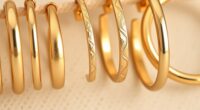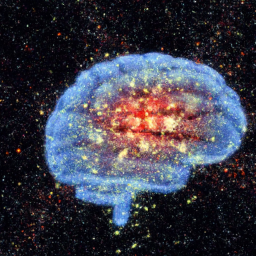Wearable sleep trackers use sensors to monitor your sleep patterns, detecting stages like REM sleep to help you optimize your sleep cycle for better rest and dream recall. They provide personalized insights with AI-driven analysis and can include features like gentle vibrations or sounds to influence sleep stages, supporting lucid dreaming efforts. By timing your sleep and identifying ideal moments for dreaming, you can increase your chances of successful lucid experiences. Keep exploring to discover how these devices can transform your sleep and dream journey.
Key Takeaways
- Wearable sleep trackers provide detailed sleep data to optimize REM cycles for improved lucid dreaming potential.
- They enable personalized sleep adjustments through AI-driven insights, enhancing dream recall and lucid dreaming success.
- Sensors detect sleep stages and disruptions, supporting techniques like WBTB and MILD for better lucid dream induction.
- Data analytics reveal dream patterns and triggers, helping users develop habits for longer REM sleep and vivid dreams.
- These devices support dream exploration businesses by offering valuable insights for product development and targeted marketing.
If you’re looking to improve your sleep quality, wearable sleep trackers can be valuable tools. These devices monitor your sleep patterns and provide insights into your sleep cycle, which is vital for understanding how well you’re resting. By tracking your sleep stages—light, deep, and REM—you can identify patterns that influence your overall sleep health. Knowing your sleep cycle helps you fine-tune your sleep schedule, ensuring you wake up feeling refreshed rather than groggy. Additionally, many sleep trackers include features designed to enhance dream recall, a key aspect for those interested in lucid dreaming or simply wanting to remember their dreams more vividly. When you understand your sleep patterns, you can better time your sleep to maximize REM phases, during which dreaming occurs most vividly. This increases the likelihood of recalling dreams, which can be a stepping stone toward lucid dreaming practices.
Many wearable sleep trackers use sensors that detect movement, heart rate, and even skin temperature to map your sleep cycle accurately. As you sleep, these devices collect data and often sync with smartphone apps, giving you detailed reports on your sleep quality. By reviewing these insights regularly, you can spot disruptions, such as frequent awakenings or irregular sleep patterns, and take steps to improve them. Recognizing how your sleep cycle fluctuates throughout the night helps you develop habits that promote longer periods of REM sleep, enhancing both dream recall and overall rest. For instance, some advanced devices even provide gentle vibrations or sounds to nudge you into lighter sleep stages at the best times, making it easier to remember dreams or achieve lucid states. Moreover, understanding the influence of AI-driven analytics can help optimize your sleep routines based on large datasets and personalized recommendations. Additionally, tracking your sleep can reveal sleep pattern irregularities that might be linked to lifestyle factors or health concerns, enabling proactive adjustments.
Furthermore, understanding your sleep cycle through tracking can influence your approach to lucid dreaming. When you know the timing of your REM phases, you can plan specific techniques like Wake-Back-to-Bed (WBTB) or Mnemonic Induction of Lucid Dreams (MILD) more effectively. These methods often involve waking up during or after REM sleep to boost your chances of becoming aware that you’re dreaming. The better your dream recall, the more you can analyze your dreams afterward, recognizing patterns or triggers that could help you gain control within your dreams. Wearable sleep trackers don’t just improve sleep quality—they can serve as powerful tools for those interested in exploring lucid dreaming, helping you harness your sleep cycle for both better rest and more vivid, memorable dreams. Additionally, precise sleep stage detection enhances the accuracy of your sleep data, making your insights even more actionable and personalized.
Frequently Asked Questions
How Accurate Are Wearable Sleep Trackers in Detecting REM Sleep?
You wonder how accurate wearable sleep trackers are in detecting REM sleep. These devices rely on sensors to monitor your sleep cycle, but their accuracy depends heavily on proper device calibration. While many trackers can identify REM stages with reasonable precision, some variability exists due to individual differences and movement. So, expect some margin of error, especially if the device isn’t well-calibrated or if your sleep patterns are irregular.
Can Wearable Devices Influence the Quality of Lucid Dreaming Experiences?
Ever wondered if a device could boost your lucid dreaming? Wearable devices can influence your dreams by providing gentle cues or sounds, especially when combined with practices like mindfulness meditation and dream journaling. These tools help train your brain to recognize dream signs, increasing your chances of lucidity. While they don’t guarantee perfect control, they can enhance your overall dream quality and awareness, making your lucid dreams more vivid and memorable.
Are Wearable Sleep Trackers Suitable for All Age Groups?
You might wonder if wearable sleep trackers are suitable for all age groups. While they offer valuable insights, their age appropriateness varies—young children and older adults may find some devices less accessible or comfortable. Consider device accessibility and safety features for different ages. Always check if the device is designed for the specific age group, ensuring safe and effective use to improve your sleep and lucid dreaming experiences.
How Do Different Brands Compare in Tracking Sleep Stages?
When comparing brands for tracking sleep stages, you’ll notice variations in brand reliability and feature variety. Some brands excel in accuracy and consistent data, making them more dependable. Others offer a wider range of features like heart rate monitoring or sleep cycle analysis, giving you more insights. Your choice depends on whether you prioritize reliable sleep data or value the broader feature set. Consider your specific needs to find the best fit.
What Privacy Concerns Exist With Wearable Sleep Data Collection?
Imagine your sleep data as a secret garden—beautiful but vulnerable. You might worry about data privacy, as companies could share or sell your sensitive info without clear user consent. This risks exposing personal patterns or health details. Always guarantee you understand how your data is used, and that your consent is informed. Protecting your sleep data is like guarding a treasure—value it, and be cautious about who has access.
Conclusion
By now, you can see how wearable sleep trackers are transforming your dreaming experience. They offer real-time insights, helping you achieve lucidity more often. Did you know that over 60% of users report increased dream awareness within just a month? With this data-driven approach, you’re empowered to explore your subconscious like never before. Embrace the technology and reveal the mysteries of your dreams—your journey to lucid dreaming starts now.










